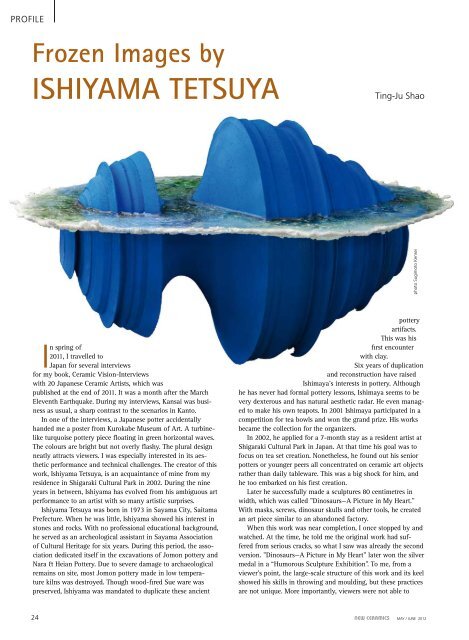3. Juni 2012 - New Ceramics
3. Juni 2012 - New Ceramics
3. Juni 2012 - New Ceramics
You also want an ePaper? Increase the reach of your titles
YUMPU automatically turns print PDFs into web optimized ePapers that Google loves.
PROFILE<br />
Frozen Images by<br />
IshIyama TeTsuya<br />
In spring of<br />
2011, I travelled to<br />
Japan for several interviews<br />
for my book, Ceramic Vision-Interviews<br />
with 20 Japanese Ceramic Artists, which was<br />
published at the end of 2011. It was a month after the March<br />
Eleventh Earthquake. During my interviews, Kansai was business<br />
as usual, a sharp contrast to the scenarios in Kanto.<br />
In one of the interviews, a Japanese potter accidentally<br />
handed me a poster from Kurokabe Museum of Art. A turbinelike<br />
turquoise pottery piece floating in green horizontal waves.<br />
The colours are bright but not overly flashy. The plural design<br />
neatly attracts viewers. I was especially interested in its aesthetic<br />
performance and technical challenges. The creator of this<br />
work, Ishiyama Tetsuya, is an acquaintance of mine from my<br />
residence in Shigaraki Cultural Park in 2002. During the nine<br />
years in between, Ishiyama has evolved from his ambiguous art<br />
performance to an artist with so many artistic surprises.<br />
Ishiyama Tetsuya was born in 1973 in Sayama City, Saitama<br />
Prefecture. When he was little, Ishiyama showed his interest in<br />
stones and rocks. With no professional educational background,<br />
he served as an archeological assistant in Sayama Association<br />
of Cultural Heritage for six years. During this period, the association<br />
dedicated itself in the excavations of Jomon pottery and<br />
Nara & Heian Pottery. Due to severe damage to archaeological<br />
remains on site, most Jomon pottery made in low temperature<br />
kilns was destroyed. Though wood-fired Sue ware was<br />
preserved, Ishiyama was mandated to duplicate these ancient<br />
Ting-Ju Shao<br />
pottery<br />
artifacts.<br />
This was his<br />
first encounter<br />
with clay.<br />
Six years of duplication<br />
and reconstruction have raised<br />
Ishimaya’s interests in pottery. Although<br />
he has never had formal pottery lessons, Ishimaya seems to be<br />
very dexterous and has natural aesthetic radar. He even managed<br />
to make his own teapots. In 2001 Ishimaya participated in a<br />
competition for tea bowls and won the grand prize. His works<br />
became the collection for the organizers.<br />
In 2002, he applied for a 7-month stay as a resident artist at<br />
Shigaraki Cultural Park in Japan. At that time his goal was to<br />
focus on tea set creation. Nonetheless, he found out his senior<br />
potters or younger peers all concentrated on ceramic art objects<br />
rather than daily tableware. This was a big shock for him, and<br />
he too embarked on his first creation.<br />
Later he successfully made a sculptures 80 centimetres in<br />
width, which was called "Dinosaurs—A Picture in My Heart."<br />
With masks, screws, dinosaur skulls and other tools, he created<br />
an art piece similar to an abandoned factory.<br />
When this work was near completion, I once stopped by and<br />
watched. At the time, he told me the original work had suffered<br />
from serious cracks, so what I saw was already the second<br />
version. "Dinosaurs—A Picture in My Heart" later won the silver<br />
medal in a “Humorous Sculpture Exhibition”. To me, from a<br />
viewer’s point, the large-scale structure of this work and its keel<br />
showed his skills in throwing and moulding, but these practices<br />
are not unique. More importantly, viewers were not able to<br />
24 NEW CERAMICS May / June <strong>2012</strong><br />
photo Sugimoto Kensei


